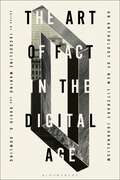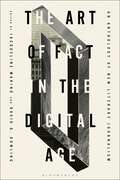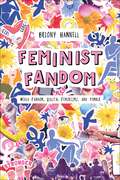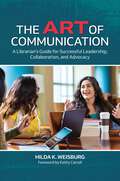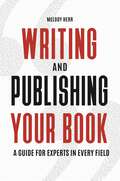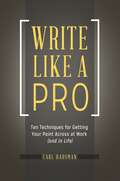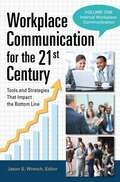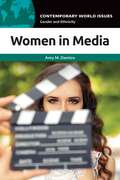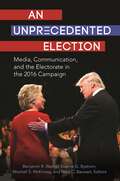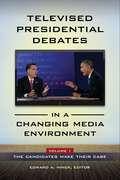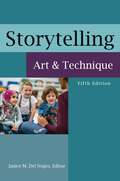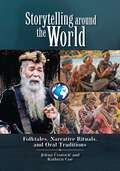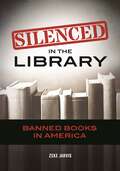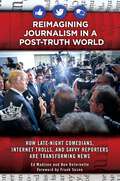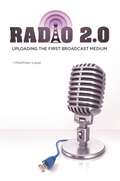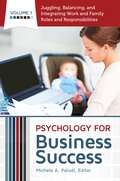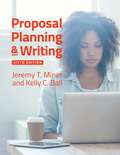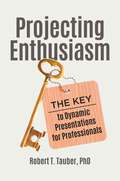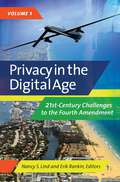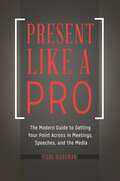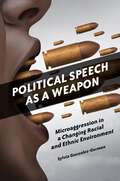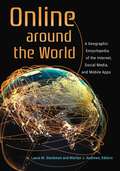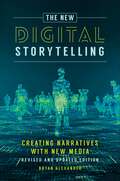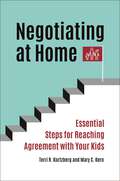- Table View
- List View
The Art of Fact in the Digital Age: An Anthology of New Literary Journalism
by Jacqueline Marino and David O. DowlingThe Art of Fact in the Digital Age is a showcase of the most powerful and moving journalism of the past 25 years. Selections include stories originally published in established bastions of literary journalism (The New York Times, The Atlantic and The New Yorker), as well as those from specialized and online publications (Runner's World, The Atavist). It features writers of extraordinary style (including Carina del Valle Schorske, Brian Phillips, and Jia Tolentino), as well as those who have profoundly influenced public discourse on the 21st century's most urgent issues: Mitchell S. Jackson, Clint Smith, and Ta-Nehisi Coates on race; Susan Dominus and Luke Mogelson on migration; and Kathryn Schulz and David Wallace-Wells on environmental threats. It even includes one story that expanded literary journalism's repertoire into audio (This American Life). This collection, assembled for students, scholars, and practitioners alike, also charts the evolution of digital longform journalism through its greatest achievements, from transitioning readers to screens to the integration of multimedia with words in service of meaning. The art of fact in the 21st century opened new ranges of expression to address such issues, while uniquely bearing the imprint of their generation's digital cultures and technologies. Although many forces compete for attention in the digital age, story triumphs. The works in this anthology show us why.
The Art of Fact in the Digital Age: An Anthology of New Literary Journalism
The Art of Fact in the Digital Age is a showcase of the most powerful and moving journalism of the past 25 years. Selections include stories originally published in established bastions of literary journalism (The New York Times, The Atlantic and The New Yorker), as well as those from specialized and online publications (Runner's World, The Atavist). It features writers of extraordinary style (including Carina del Valle Schorske, Brian Phillips, and Jia Tolentino), as well as those who have profoundly influenced public discourse on the 21st century's most urgent issues: Mitchell S. Jackson, Clint Smith, and Ta-Nehisi Coates on race; Susan Dominus and Luke Mogelson on migration; and Kathryn Schulz and David Wallace-Wells on environmental threats. It even includes one story that expanded literary journalism's repertoire into audio (This American Life). This collection, assembled for students, scholars, and practitioners alike, also charts the evolution of digital longform journalism through its greatest achievements, from transitioning readers to screens to the integration of multimedia with words in service of meaning. The art of fact in the 21st century opened new ranges of expression to address such issues, while uniquely bearing the imprint of their generation's digital cultures and technologies. Although many forces compete for attention in the digital age, story triumphs. The works in this anthology show us why.
Feminist Fandom: Media Fandom, Digital Feminisms, and Tumblr
by Briony HannellExamines how fannish and feminist modes of cultural consumption, production, and critique are converging and opening up informal spaces for young people to engage with feminism. Adopting an interdisciplinary theoretical framework and bringing together media and communications, feminist cultural studies, sociology, internet studies and fan studies, Hannell locates media fandom at the intersection of the multi-directional and co-constitutive relationship between popular feminisms, popular culture and participatory networked digital cultures. Feminist Fandom functions as an ethnographic account of how feminist identities are constructed, lived and felt through digital fannish spaces on the micro-blogging and social networking platform, Tumblr.
Feminist Fandom: Media Fandom, Digital Feminisms, and Tumblr
by Briony HannellExamines how fannish and feminist modes of cultural consumption, production, and critique are converging and opening up informal spaces for young people to engage with feminism. Adopting an interdisciplinary theoretical framework and bringing together media and communications, feminist cultural studies, sociology, internet studies and fan studies, Hannell locates media fandom at the intersection of the multi-directional and co-constitutive relationship between popular feminisms, popular culture and participatory networked digital cultures. Feminist Fandom functions as an ethnographic account of how feminist identities are constructed, lived and felt through digital fannish spaces on the micro-blogging and social networking platform, Tumblr.
The Art of Communication: A Librarian's Guide for Successful Leadership, Collaboration, and Advocacy
by Hilda K. WeisburgLibrarians will learn communication skills that help them develop as leaders, build community, and advocate for their libraries.Librarians understand the importance of making the value of the library known to stakeholders. In this informative and conversational book, Hilda K. Weisburg gradually builds librarians' communication skills, which are intrinsic to the success of library programs and services. Being able to effectively communicate as a sender and receiver of messages is a vital leadership skill, and librarians must master all the multi-faceted ways people exchange information in order to grow as leaders.Throughout the book, librarians will learn communication basics and the obstacles that interfere with successful communication. The chapters in part one detail the three components of communication; part two prepares librarians to cope with difficult communications; and part three gives librarians further techniques to ensure their messages are cohesive and strategic as they reach out to stakeholders.The book's goal is for librarians to feel confident about using their newly learned communication skills for advocacy. As their value to the library community grows, they will be able to strategically use the relationships their communications have built to create positive change.
Writing and Publishing Your Book: A Guide for Experts in Every Field
by Melody Herr Ph.D.Are you ready to write your book? Partner with an experienced publisher, writing coach, and author and find out how to turn your research and scholarship into a book.This book is the next-best-thing to a personal writing coach. Drawing upon her own extensive experience as an author and publisher, Melody Herr guides the reader through every step of the writing and publishing process: constructing a table of contents, preparing a proposal, finding a publisher, negotiating a contract, drafting the manuscript, and marketing the finished product. Throughout, she offers proven strategies for producing a book that highlights its author's authoritative knowledge and writing skills. Unique among writing guides, Writing and Publishing Your Book: A Guide for Experts in Every Field acknowledges the reader's own expertise; speaks to researchers and scholars across the sciences, social sciences, and humanities; and provides information and guidance that will benefit junior authors as well as their more senior colleagues. By following these practical, step-by-step instructions, new authors will more easily liberate their own creativity while avoiding the many pitfalls that mire new writers, thereby maintaining momentum for a successful publication.
Write Like a Pro: Ten Techniques for Getting Your Point Across at Work (and in Life)
by Carl HausmanFor those looking to become great business writers, this practical guide supplies clear instruction and examples of how to organize thoughts into written form, impart information with pinpoint accuracy, persuade, and hold the reader's interest: in short, to use language to get what you want.In today's business world, writers need to be prepared and comfortable with various forms of writing: reports, blogs, social media, white papers. Written by an established expert on writing and communication, journalism professor Carl D. Hausman, Write Like a Pro: Ten Techniques for Getting Your Point Across at Work (and in Life) can make you a better writer, regardless of your experience and current skill level; and will teach you how to vastly improve your written communication through a straightforward, easy-to-follow method.This book doesn't just cover the essential "mechanics" of good writing; it focuses on developing the more subtle skills of infusing your writing with eloquence, power, accuracy, and persuasiveness—and it shows readers how to achieve those qualities with no-nonsense advice. The information is highly accessible, sometimes amusing, and replete with memorable examples that demonstrate what works and teaches a strategy for solving any writing problem. It is essential reading for anyone who wants to write effectively, in any form, from emails to complaint letters to social media.
Workplace Communication for the 21st Century [2 volumes]: Tools and Strategies That Impact the Bottom Line [2 volumes]
by Jason S. WrenchWritten in clear, non-technical language, this book explains how employees and employers can maximize internal and external organizational communication—for both personal benefit and to the entity as a whole.Workplace Communication for the 21st Century: Tools and Strategies That Impact the Bottom Line explains and simplifies what organizational communication scholars have learned, presenting this knowledge so that it can be easily applied to generate tangible benefits to employees and employers as they face everyday challenges in the real world.This two-volume work discusses internal organizational and external organizational communication separately, first explaining how communication functions within the confines of a modern organization, then addressing how organizations interact with various stakeholders, such as customers, clients, and regulatory agencies. The expert contributors provide a thorough and insightful view on organizational communication and supply a range of strategies that will be useful to practitioners and academics alike.
Women in Media: A Reference Handbook (Contemporary World Issues)
by Amy M. DamicoThis title provides a broad overview of how women are portrayed and treated in America's news and entertainment industries, including film, television, radio, the internet, and social media.This book provides a one-stop resource for understanding the participation and representation of women in the U.S. media in such areas as narrative film, scripted television programming, advertising, video games, news, and sports. Coverage is wide-ranging and comprehensive, covering historical developments and trends as well as such relevant issues as gender disparities in pay and advancement opportunities, stereotypical gender portrayals in popular entertainment, sexual harassment in America's media and entertainment industries, and the dearth of positive media representations of women of color.Engaging with this history and reading about current issues related to this topic will be useful to those interested in understanding more about why women's engagement in media—in such roles as performer, journalist, producer, and writer—is important. It will also help readers better understand how and why problematic media representations of women hinder efforts to achieve full gender equality in American society.
An Unprecedented Election: Media, Communication, and the Electorate in the 2016 Campaign
by Benjamin R. Warner, Dianne G. Bystrom, Mitchell S. McKinney, and Mary C. Banwart, EditorsWritten by leading scholars in the field of political communication, this book provides a comprehensive accounting of the campaign communication that characterized the unprecedented 2016 presidential campaign.The political events leading up to election day on November 8, 2016, involved unprecedented events in U.S. history: Hillary Clinton was the first female to be nominated by a major party, and she was favored to win the highest seat in the nation. Donald Trump, arguably one of the most unconventional and most-unlikely-to-succeed candidates in U.S. history, became the leading candidate against Clinton. Then, an even more surprising thing happened: Trump won, an outcome unexpected by all experts and statistical models.An Unprecedented Election: Media, Communication, and the Electorate in the 2016 Campaign presents proprietary research conducted by a national election team and leading scholars in political communication and documents the most significant—and in some cases, the most shocking—features of the 2016 U.S. presidential election. The information presented in this book is derived from national surveys, experiments, and textual analysis, and it will help readers to grasp the truly unique characteristics of this campaign that make it unlike any other in U.S. history. The chapters explain the underlying dynamics of this astonishing election by assessing the important role of both traditional and social media, the evolving (and potentially diminishing) influence of televised campaign advertisements, the various implications of three historic presidential debates, and the contextual significance of convention addresses. Readers will come away with an appreciation of the content and effects of the campaign communication and media coverage as well as the unique attributes of the electorate that ultimately selected Donald Trump as the 45th president of the United States.
Televised Presidential Debates in a Changing Media Environment [2 volumes]: [2 volumes]
by Edward A. HinckThis two-volume set examines recent presidential and vice presidential debates, addresses how citizens make sense of these events in new media, and considers whether the evolution of these forms of consumption is healthy for future presidential campaigns—and for democracy.The presidential debates of 2016 underscored how television highlights candidates' and campaigns' messages, which provide fodder for citizens' widespread use of new media to "talk back" to campaigns and other citizens. Social media will continue to affect the way that campaign events like presidential debates are consumed by audiences and how they shape campaign outcomes. This two-volume study is one of the first to examine the relationship between debates as televised events and events consumed by citizens through social media. It also assesses the town hall debate format from 1992 to 2016, uses the lens of civil dialogue to consider how citizens watch the debates, and considers the growing impact of new media commentary on candidate images that emerge in presidential and vice presidential debates.Televised Presidential Debates in a Changing Media Environment features contributions from leading political communication scholars that illuminate how presidential debates are transforming from events that are privately contemplated by citizens, to events that are increasingly viewed and discussed by citizens through social media. The first volume focuses on traditional studies of debates as televised campaign events, and the second volume examines the changing audiences for debates as they become consumed and discussed by viewers outside the traditional channels of newspapers, cable news channels, and campaign messaging. Readers will contemplate questions of new forms, problems, and possibilities of political engagement that are resulting from citizens producing and consuming political messages in new media.
Storytelling: Art and Technique
by Janice M. Del NegroThis book serves as both a textbook and reference for faculty and students in LIS courses on storytelling and a professional guide for practicing librarians, particularly youth services librarians in public and school libraries.Storytelling: Art and Technique serves professors, students, and practitioners alike as a textbook, reference, and professional guide. It provides practical instruction and concrete examples of how to use the power of story to build literacy and presentation skills, as well as to create community in those same educational spaces.This text illustrates the value of storytelling, covers the history of storytelling in libraries, and offers valuable guidance for bringing stories to contemporary listeners, with detailed instructions on the selection, preparation, and presentation of stories. It also provides guidance around the planning and administration of a storytelling program. Topics include digital storytelling, open mics and slams, and the neuroscience of storytelling. An extensive and helpful section of resources for the storyteller is included in an expanded Part V of this edition.
Storytelling around the World: Folktales, Narrative Rituals, and Oral Traditions
by Jelena Cvorovic Kathryn CoeThis book provides students, instructors, and lay-readers with a cross-cultural understanding of storytelling as an art form that has existed for centuries, from the first spoken and sung stories to those that are drawn and performed today.This book serves as an indispensable resource for students and scholars interested in storytelling and in multicultural approaches to the arts. By taking an evolutionary approach, this book begins with a discussion of origin stories and continues through history to stories of the 21st century. The text not only engages the stories themselves, it also explains how individuals from all disciplines, from doctors and lawyers to priests and journalists, use stories to focus their readers' and listeners' attention and influence them.This text addresses stories and storytelling across both time (thousands of years) and geography, including in-depth descriptions of storytelling practices occurring in more than 40 different cultures around the world. Part I consists of thematic essays, exploring such topics as the history of storytelling, common elements across cultures, different media, lessons stories teach us, and storytelling today. Part II looks at more than 40 different cultures, with entries following the same outline: Overview, Storytellers: Who Tell the Stories, and When, Creation Mythologies, Teaching Tales and Values, and Cultural Preservation. Several tales/tale excerpts accompany each entry.
Silenced in the Library: Banned Books in America
by Zeke JarvisCensorship has been an ongoing phenomenon even in "the land of the free." This examination of banned books across U.S. history examines the motivations and effects of censorship, shows us how our view of right and wrong has evolved over the years, and helps readers to understand the tremendous importance of books and films in our society.Books ranging from classics such as A Farewell to Arms, Lord of the Rings, The Catcher in the Rye, and The Color Purple as well as best-selling books such as Are You There, God? It's Me Margaret, titles in the Harry Potter series, and various books by bestselling novelist Stephen King have all been on the banned books list. What was the content that got them banned, who wanted them banned, and did the ban have the desired effect of minimizing the number of people who read the title—or did it have the opposite effect, inadvertently creating an even larger readership for the book?Silenced in the Library: Banned Books in America provides a comprehensive examination of the challenges to major books as well as the final results of these selections being deemed "unfit for public consumption." Included in its discussion are explanations of the true nature of the objections along with the motives of the authors, publishers, and major proponents of the books. Content is organized based on why the books were banned, such as sexual content, drug use, or religious objections. This approach helps readers to see trends in how people have approached the challenge of evaluating what is "proper" and shows how our societal consensus of what is acceptable has evolved over the years. Readers will come away with a fuller appreciation of the immense power of words on a page—or an eReader device—to inflame and outrage, influence opinion, incite thought, and even change the course of history.
Reimagining Journalism in a Post-Truth World: How Late-Night Comedians, Internet Trolls, and Savvy Reporters Are Transforming News
by Ed Madison Ben DeJarnetteAmidst "alternative facts" and "post-truth" politics, news journalism is more important and complex than ever. This book examines journalism's evolution within digital media's ecosystem where lies often spread faster than truth, and consumers expect conversations, not lectures.Tthe 2016 U.S. presidential election delivered a stunning result, but the news media's breathless coverage of it was no surprise. News networks turned debates into primetime entertainment, reporters spent more time covering poll results than public policy issues, and the cozy relationship between journalists and political insiders helped ensure intrigue and ratings, even as it eroded journalism's role as democracy's "Fourth Estate." Against this sobering backdrop, a broadcast news veteran and a millennial newshound consider how journalism can regain the public's trust by learning from pioneers both within and beyond the profession. Connecting the dots between faux news, "fake news," and real news, coauthors Madison and DeJarnette provide an unflinching analysis of where mainstream journalism went wrong—and what the next generation of reporters can do to make it right. The significance of Donald Trump's presidency is not lost on the authors, but Reimagining Journalism in a Post-Truth World is not a post-mortem of the 2016 presidential election, nor is it a how-to guide for reporting on Trump's White House. Instead, this accessible and engaging book offers a broader perspective on contemporary journalism, pairing lively anecdotes with insightful analysis of long-term trends and challenges. Drawing on their expertise in media innovation and entrepreneurship, the authors explore how comedians like John Oliver, Trevor Noah, and Samantha Bee are breaking (and reshaping) the rules of political journalism; how legacy media outlets like The Boston Globe, The Washington Post, and The New York Times are retooling for the digital age; and how newcomers like Vice, Hearken, and De Correspondent are innovating new models for reporting and storytelling. Anyone seeking to make sense of modern journalism and its intersections with democracy will want to read this book.
Radio 2.0: Uploading the First Broadcast Medium
by Matthew LasarWelcome to the uncertain world of "Radio 2.0"—where podcasts, mobile streaming, and huge music databases are the new reality, as are tweeting deejays and Apple's Siri serving as music announcer—and understand the exciting status this medium has, and will continue to have, in our digitally inclined society.How did popular radio in past decades—from President Franklin D. Roosevelt's "Fireside Chats" in the 1930s through Top 40 music and Rush Limbaugh's talk radio empire—shape American society? How did devices and systems like the iPhone, Pandora, and YouTube turn the radio industry upside-down? Does radio still have a future, and if so, what will we want it to look like?Radio 2.0: Uploading the First Broadcast Medium covers the history and evolution of Internet radio, explaining what came before, where Internet radio came from, and where it is likely headed. It also gives readers a frame of reference by describing radio from its introduction to American audiences in the 1920s—a medium that brought people together through a common experience of the same broadcast—and shows how technologies like digital music and streaming music services put into question the very definition of "radio." By examining new radio and media technologies, the book explores an important societal trend: the shift of media toward individualized or personalized forms of consumption.
Psychology for Business Success [4 volumes]: [4 volumes]
by Michele A. PaludiThis comprehensive, four-volume work presents practical, up-to-date recommendations in areas impacting all job applicants and employees, including work/life balance, diversity management, performance, recruitment, training programs, and employee conflict.This four-volume set uniquely integrates legislation, management theories, and social science research to cover a variety of human resource management topics, such as leadership and managerial styles, generational conflict in the workplace, techniques for evaluating employee performance, and workplace violence. In addition, best practices for policies, investigation procedures, and implementing training programs are covered—all information that can result in dramatic improvements in the workplace environment and business success.Every recommendation in this set is reflective of—as well as responsive to— the needs of employees. The overall objective of the work is to provide readers with effective management strategies to work strategically, ethically, honestly, and effectively with people. Additionally, the contents emphasize the importance of gaining an understanding of the strategic influences on managing people—for example, documenting the connections between business and psychological strategies like effective listening.
Proposal Planning & Writing
by Jeremy T. Miner Kelly C. Ball-StahlNo matter whether you are approaching public or private sponsors, this thorough and detailed step-by-step guide will enable you to plan and write winning proposals.Grantseeking is always a competitive process. As organizational needs outstrip resources, groups turn to grants as a means of strengthening their financial footing while pursuing their missions. This book draws on the authors' three decades of grantseeking experiences in writing successful proposals, conducting grant workshops nationwide, reviewing government and foundation proposals, and critiquing application guidelines for grantmakers to lead readers through the process of planning and writing successful proposals. The authors first provide practical strategies for project planning, including identifying sponsors, matching grantseeker needs to sponsor priorities, and qualifying prospects through pre-proposal contacts. The authors then guide users systematically through proposal writing, including introducing a template for letter proposals to private foundations and corporations, describing the primary elements of government proposals, and providing tips for constructing a realistic budget. This advice as well as the key questions to answer before you begin writing; actual proposals that were declined, with rejection reasons; and complete sample letter proposals comprised in this volume will help both beginning and experienced grantseekers to better plan and develop fundable projects.
Projecting Enthusiasm: The Key to Dynamic Presentations for Professionals
by Robert T. TauberRegardless of your profession as a teacher, doctor, writer, or business associate, every presentation is a performance. To know your material is important, but to project your enthusiasm for the subject is just as vital to engage your audience.Research supports that presenters who boast an enthusiastic flair best engage, inform, and motivate their audiences. Dr. Robert Tauber uses his expertise to train you in the most effective presentation tools, with a joyful touch.Delivering a set of performance skills proven to deliver palpable results, Projecting Enthusiasm will teach you how to integrate suspense and surprise, humor, props, voice animation, creative entrances and exits, and more into your next performance. This book won't try to rewrite your speech or bombard you with intimidating critiques. Instead, you will learn that the passion you present gives your message an essential meaning and makes your audience value it as one worth listening to. Projecting Enthusiasm harnesses the exuberant, creative, and informative elements you want to bring to your next presentation and shows you how to do it.
Privacy in the Digital Age [2 volumes]: 21st-Century Challenges to the Fourth Amendment [2 volumes]
by Nancy S. Lind and Erik RankinA collection of expert essays examines the privacy rights that have been lost in the post-9/11 era—giving students and others the knowledge they need to take back their constitutional protections.This timely two-volume collection shares information every citizen should have, tackling the erosion of privacy rights engendered by the ability of digital technology to intercept, mine, and store personal data, most often without the knowledge of those being monitored. Examining its subject through the lens of Fourth Amendment rights, the work focuses on technological advances that now gather personal data on an unprecedented scale, whether by monitoring social media, tracking cell phones, or using thermal imaging to watch people's movement. It also examines the possible impact of the widespread gathering of such data by law enforcement and security agencies and by private corporations such as Google.Organized by hot-button topics confronting U.S. citizens in the post-9/11 era, the work reviews the original intent of the Fourth Amendment and then traces the development and erosion of interpretations of that amendment in the 21st century. Topical essays offer a comprehensive treatment and understanding of current Fourth Amendment issues, including those that have been brought before the courts and those relative to the continuing governmental and societal emphasis on security and public safety since the Columbine shootings in 1999 and the events of September 11, 2001.
Present Like a Pro: The Modern Guide to Getting Your Point Across in Meetings, Speeches, and the Media
by Carl HausmanHighly accessible, full of memorable examples, and at times amusing, this book presents ten powerful techniques for getting your point across in all venues—including new media.In today's world, nearly everyone, including business professionals and executives, salespeople, teachers, authors, and entrepreneurs—in short, anyone who needs to put an idea before others—needs strong presentation and persuasion skills. Moreover, just as important as traditional public speaking skills is the ability to present effectively via various media. Today's presentation is just as likely to be given over Skype or on YouTube as in a room, before a live audience.Present Like a Pro shares the expertise of a veteran presenter who knows what is demanded in today's marketplace and has lectured publicly, appeared on television, and testified before Congress. The straightforward, step-by-step instructions provide a sensible "plan of attack" for preparing and presenting. The ten techniques give readers the ability to simplify the challenge of presenting, to understand what works, and to develop an effective strategy for solving any presentation problems not directly covered in the book. Author Carl Hausman addresses all of the common problems for those new to presenting or working in a new environment, such as overcoming stage fright, injecting humor and wit into a presentation while delivering credible expertise, and winning over an inattentive, skeptical, or hostile audience.
Political Speech as a Weapon: Microaggression in a Changing Racial and Ethnic Environment
by Sylvia Gonzalez-GormanProvides a penetrating examination of how political rhetoric from public officials creates tensions via microaggression cues due to changing demographics, campaign rhetoric, and the use of social media.What are microaggression cues, and what are examples of those cues in political rhetoric? How have microaggression cues from former presidents, elected officials, political candidates, and former candidate, now President, Trump led to further polarization of America's citizens? What are the connections between these microaggression cues, the demographic shift of the United States, and the growing fear among longtime majority populations?Political Speech as a Weapon: Microaggression in a Changing Racial and Ethnic Environment answers these questions and helps readers understand related topics such as nativism, the transformation process of the U.S. population and cultural norms, and how Americans can best respond to evolving conditions to meet these challenges. Author Sylvia Gonzalez-Gorman addresses a blind spot in the field of American politics and connects hostile rhetoric by public officials to the effect of such rhetoric, which leads to the marginalization of groups and a polarizing cultural environment. The book specifically focuses on the role of political rhetoric as a microaggression cue and clearly illustrates how these cues are a well established—and damaging—component of U.S. political culture.
Online around the World: A Geographic Encyclopedia of the Internet, Social Media, and Mobile Apps
by Laura M. Steckman and Marilyn J. Andrews, EditorsCovering more than 80 countries around the world, this book provides a compelling, contemporary snapshot of how people in other countries are using the Internet, social media, and mobile apps.How do people in other countries use the social media platform Facebook differently than Americans do? What topics are discussed on the largest online forum—one in Indonesia, with more than seven million registered users? Why does Mongolia rate in the top-ten countries worldwide for peak Internet speeds? Readers of Online around the World: A Geographic Encyclopedia of the Internet, Social Media, and Mobile Apps will discover the answers to these questions and learn about people's Internet and social media preferences on six continents—outside of the online community of users within the United States. The book begins with an overview of the Internet, social media platforms, and mobile apps that chronologically examines the development of technological innovations that have made the Internet what it is today. The country-specific entries that follow the overview provide demographic information and describe specific events influenced by online communications, allowing readers to better appreciate the incredible power of online interactions across otherwise-unconnected individuals and the realities and peculiarities of how people communicate in today's fast-paced, globalized, and high-technology environment. This encyclopedia presents social media and the Internet in new light, identifying how the use of language and the specific application of human culture impacts emerging technologies and communications, dramatically affecting everything from politics to social activism, education, and censorship.
The New Digital Storytelling: Creating Narratives with New Media--Revised and Updated Edition
by Bryan AlexanderNewly revised and updated, this is the essential guide to state-of-the-art digital storytelling for audiences, creators, and teachers.Written for everyone interested in the communication potential of digital media, including educators, marketers, communication professionals, and community activists, this is the ultimate guide to harnessing technology for storytelling. No other book covers the digital storytelling movement as thoroughly as this updated second edition of a popular work, nor does any incorporate as many technologies, from video to augmented reality, mobile devices to virtual reality.The book combines history, analysis, and practical guidance about digital storytelling. It begins with a history that encompasses an exploration of storytelling itself, as well as a description of narratives using digital tools from the 1980s through 2000. From there, the author dives into modern digital storytelling, offering analysis and guidance regarding the use of digital video, podcasting, social media, gaming, mobile devices, and virtual and augmented reality. The work concludes with practical advice about how to create and share digital stories using the most current tools so even the new would-be storyteller can create their first digital narrative. Of course, the second edition is updated to take into account the many ways the field has advanced since the original book appeared. With many new examples of digital stories, this edition's evidence base is current and fresh. New or transformed technologies are also addressed, including virtual reality; mobile devices that have become mainstream tools for creating, sharing, and experiencing digital stories; and the wide variety of new storytelling apps and services.
Negotiating at Home: Essential Steps for Reaching Agreement with Your Kids
by Terri R. Kurtzberg Mary C. KernWhy do parents who can pull off multi-million dollar deals at work then go home and stumble with their kids?Parents spend an awful lot of time negotiating with their kids—over everyday requests, rules and policies, and big decisions, and often end up derailed and frustrated. In Negotiating at Home, Kurtzberg and Kern offer parents a chance to look more closely at what they already do well (and why) and what can be done better. Grounded in decades of research on how to negotiate effectively, parents will learn about how to plan, recognize specific tactics, communicate and work in partnerships with other family members, address fairness, and handle conflict.
